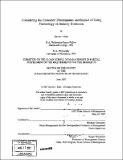| dc.contributor.advisor | Michael Cusumano. | en_US |
| dc.contributor.author | Kahl, Steven J. (Steven John) | en_US |
| dc.contributor.other | Sloan School of Management. | en_US |
| dc.date.accessioned | 2008-03-27T18:19:19Z | |
| dc.date.available | 2008-03-27T18:19:19Z | |
| dc.date.copyright | 2007 | en_US |
| dc.date.issued | 2007 | en_US |
| dc.identifier.uri | http://hdl.handle.net/1721.1/40887 | |
| dc.description | Thesis (Ph. D.)--Massachusetts Institute of Technology, Sloan School of Management, 2007. | en_US |
| dc.description | Includes bibliographical references (p. 222-232). | en_US |
| dc.description.abstract | This dissertation raises two questions: How do customers come to understand and use a technology? What is the influence of customers using a technology on industry evolution and competition? I use two historical cases to answer these questions. The first considers how insurance firms came to initially understand and use the computer in the 1940s and 50s (in collaboration with JoAnne Yates). We argue that the understanding of a new product category is related to which comparisons are actually made and why. Insurance firms made multiple comparisons that collectively helped distinguish the computer from any given pre-existing category. The second case analyzes the history of how U.S. manufacturers used manufacturing planning software from its inception in 1954 through its first significant technological change in the 1990s. Manufacturers significantly changed how they used the software primarily through learning by using the software. Market intermediaries, such as consultants, played an important role in diffusing these uses and in developing a collective understanding of the technology - what I call a dominant use. Using additional entry/exit data from the software industry, I argue that how customers use a technology helps explain the industry's population dynamics. I argue that the emergence of a new dominant use, even without a corresponding technological change, can lead to significant new market entry. In addition, established firms are less likely to fail when customers use a new technology in similar ways to how they used the old technology. | en_US |
| dc.description.abstract | (cont..) More generally, firms - established or not - are more likely to survive the introduction of a new technology if they are able identify and adapt their products to how customers develop uses for that product. The dissertation concludes by considering the scope conditions of this argument and further theoretical and managerial implications of more explicitly treating the processes through which customers use a technology. | en_US |
| dc.description.statementofresponsibility | by Steven J. Kahl. | en_US |
| dc.format.extent | 232 p. | en_US |
| dc.language.iso | eng | en_US |
| dc.publisher | Massachusetts Institute of Technology | en_US |
| dc.rights | M.I.T. theses are protected by
copyright. They may be viewed from this source for any purpose, but
reproduction or distribution in any format is prohibited without written
permission. See provided URL for inquiries about permission. | en_US |
| dc.rights.uri | http://dspace.mit.edu/handle/1721.1/7582 | en_US |
| dc.subject | Sloan School of Management. | en_US |
| dc.title | Considering the customer : determinants and impact of using technology on industry evolution | en_US |
| dc.type | Thesis | en_US |
| dc.description.degree | Ph.D. | en_US |
| dc.contributor.department | Sloan School of Management | |
| dc.identifier.oclc | 196539729 | en_US |
